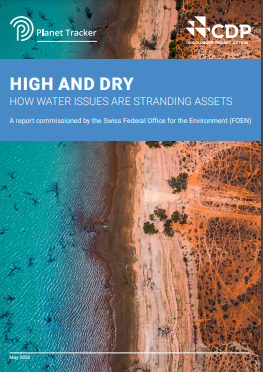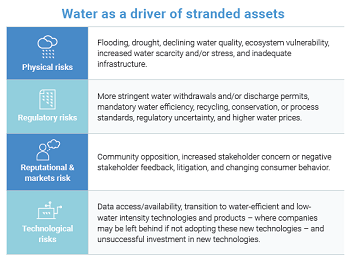New report finds US$13.5 billion in assets are already stranded and US$2 billion at risk due to water issues
- May 5, 2022
- Posted by: Elaine Coles
- Category: Global, Investment and Finance, Reports, Water Issues, Africa, Asia, Australasia, Middle East, North America, South America

A new report released today by non-profits CDP and Planet Tracker reveals how financial institutions are exposed to significant risks posed by depleted and contaminated water supplies.
The report – High And Dry – How Water Issues Are Stranding Assets – highlights how US$13.5 billion in assets are already stranded and over US$2 billion are at risk on major infrastructure projects.
The analysis, the first-of-its-kind, shows how global companies in key industries are already losing billions as a result of the global water crisis.
According to the CDP, in a world where extreme weather events are increasingly frequent, assets are more likely to be stranded than not. Key drivers of the global water crisis flagged up in the report include:
- The UN is predicting a 40% global shortfall in water supply by 2030 if current consumption and production patterns do not change.
- Furthermore, analysis by NASA suggests that 13 of the world’s 37 largest aquifers have been depleted to the point where regional water availability is threatened.
- In particular, the most overstressed aquifer in the world – the Arabian Aquifer System – provides important water supplies to more than 60 million people.
By focusing on four infrastructure sectors, oil & gas, electric utilities, coal, and metals & mining, the report found that US$13.5 billion in assets are already stranded and US$2 billion at risk due to water issues.
The projects include the Keystone oil pipeline in Canada, the epicenter of recent environmental protests and legal battles, which has already written off $US6billion. The Pascua-Lama gold mine has currently lost $7.5 billion at its project straddling the border of Chile and Argentina. The controversial Adani coal mine in Australia was found to be shouldering US$1.2 billion of risk, and $0.9 billion on the line at the Oyster Creek nuclear facility in the US.
Changes in water-related regulations, high levels of pollution, and community opposition were all cited as drivers for these stranded assets.
The projects represent the tip of the iceberg as high-quality water supplies are growing scarce while demand is increasing, quality depleting, and climate change exacerbating the crisis. The United Nations has predicted a 40% global shortfall in water supply by 2030 on current trends.
Analysis of data from CDP’s 2021 water security corporate dataset found that while the four sectors are largely factoring in water risk, the oil & gas industry stood out by providing fewer responses to the problem.
CDP calls on financial institutions to act now to engage, identify, assess, manage and disclose water risks across portfolios and loan books
The CDP is calling on financial institutions to move now to engage, identify, assess, manage and disclose water risks across portfolios and loan books to avoid the worst consequences of the water crisis and contribute to actively inhibiting it.
Cate Lamb, CDP’s global director of water security, commented:
“The global water crisis is happening right here and right now. Companies are already losing billions in revenue due to failing to factor water security into short, medium and long-term strategic decision making.
“Our new research shows that the situation is resulting in significant financial impacts not only for the companies, but for those financing them. Financial institutions need to understand how exposed they are to these risks and take immediate steps before it’s too late.
“This is a crisis which is playing out in real time and with real life consequences. For too long it’s been assumed that water supplies will always be there in abundance. This mindset has led many of the world’s freshwater aquifers to breaking point. We need to stop financial flows to risky infrastructure projects which are already haemorrhaging cash.”
Top 20 global ultimate owners hold combined US$2.7 trillion in equity in world’s most water-impactful companies
The report separately identifies those financial institutions which are most closely linked to 42 of the world’s most water-impactful companies, through shareholdings or lending activities.
The analysis found the top 20 global ultimate owners hold a combined US$2.7 trillion in equity (through active and passive holdings) in these risky companies. These owners are made up of both leading financial institutions and national governments.
 The results also show the top 20 known financial firms have provided bond, loan, and equity financing worth US$2.5 trillion over the past 10 years. Separately, the top 28 bondholders collectively hold US$30.7 billion. To compound this risk, about US$327 billion worth of financing arrangements will mature over the next five years and these companies will be seeking refinancing.
The results also show the top 20 known financial firms have provided bond, loan, and equity financing worth US$2.5 trillion over the past 10 years. Separately, the top 28 bondholders collectively hold US$30.7 billion. To compound this risk, about US$327 billion worth of financing arrangements will mature over the next five years and these companies will be seeking refinancing.
Analysis of CDP’s 2020 and 2021 financial sector dataset found one third of financial firms are still unaware of the problem (out of 377), reporting not to be assessing the implications of water insecurity during their investment or loan decisions.
The report sets out three key actions for financial institutions to take:
- Assess risks and impacts – firms should take advantage of new tools to identify risks at different levels: industrial, company, stock, and geographical factors all play a role.
- Disclose data – increasing the level of transparency is critical to understanding water risks. Many regulators are already creating mandatory disclosure requirements to address environmental crises. Financial firms should get ahead of these rulings and disclose their own portfolio water risks and impacts.
- Manage risks and impacts – firms need to create an engagement strategy which communicates the need for companies to address the water crisis. Financial institutions should put pressure on their portfolio companies to support enhanced water disclosures and measure the impact of this engagement.
According to the CDP, those firms taking action now will be ahead of the curve and in a better position to respond to inevitable policy responses, particularly on mandatory reporting.
Governments in the EU, India and Canada are currently considering mandating some form of water disclosure for financial institutions. To pave the way, CDP is making the first ever water-related information request available to 1,200 publicly listed financial institutions. This request is designed to highlight the problem and shift investments away from those which negatively impact water resources.
The report separately analyzed responses from 1,112 publicly listed companies to CDP’s 2021 water security questionnaire. The results show that 69% of these companies were exposed to water risks which could have a substantive impact on their business. The top impacts cited were reduced production, increased costs, and lower revenues. Potential losses were found to be as high as US$225bn.
Click here to download the report in full
